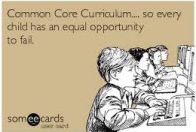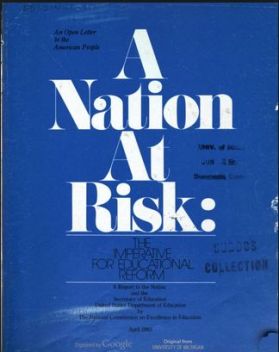I sit here, staring at a blank page, trying to come up with something to write about. I like math, it should be easy to talk about, right? I’m going to be a teacher; it should be easy to connect to real life, right? Why is this so hard? Then I realized, it’s hard because I’m forcing it. Let’s stop forcing it. Let’s stop forcing kids to do math, let’s engage them in math instead. Let’s reinvent math, let’s do it together, and let’s start now!
A Little Story….
 So, 3 and a half years ago my husband and I fostered an abused, adorable puppy from a local pound. She is an amazing dog; she is good with C, she stays in the yard, she is a good listener. But nobody is perfect, right? Libby angry poops. Yup, you read that right. When we leave her for too long, she angry poops (or pees) in the house. Our brand new, built in 2013, house. It doesn’t matter if we make sure she goes before we leave her, she saves it as our punishment for leaving. Disgusted, I pulled out her old wire kennel from the corner of the garage and set it up in the living room. It needed to be cleaned after sitting in the garage for 3 years. I took the vacuum to it, but it wasn’t enough. I pulled out one of C’s wipes (if you didn’t already know, the uses for baby wipes are endless) and began cleaning each wire rectangle. It was a long process. There were a lot of wire rectangles. Would I ever finish? When? How many rectangles are there?
So, 3 and a half years ago my husband and I fostered an abused, adorable puppy from a local pound. She is an amazing dog; she is good with C, she stays in the yard, she is a good listener. But nobody is perfect, right? Libby angry poops. Yup, you read that right. When we leave her for too long, she angry poops (or pees) in the house. Our brand new, built in 2013, house. It doesn’t matter if we make sure she goes before we leave her, she saves it as our punishment for leaving. Disgusted, I pulled out her old wire kennel from the corner of the garage and set it up in the living room. It needed to be cleaned after sitting in the garage for 3 years. I took the vacuum to it, but it wasn’t enough. I pulled out one of C’s wipes (if you didn’t already know, the uses for baby wipes are endless) and began cleaning each wire rectangle. It was a long process. There were a lot of wire rectangles. Would I ever finish? When? How many rectangles are there?


Maybe you already get where I’m going here. This is the perfect situation to talk to students about multiplication. Here I have a multiplication table all set up. Better than that, we can talk about perimeter and surface area, we can cover it all! If you really wanted to get into, I could take a video of me washing each individual rectangle. We could watch the painfully slow, boring process until students beg to know when it’s going to be over. That’s when you hit them with it, “I don’t know, why don’t you figure out how long it will take?” I got this idea from ___ who took a video of a bucket slowly being filled and made his students watch it until they begged to know when it would be over, genius! Check out his TED Talk below.
Let’s Estimate

Estimation can be difficult process. It’s takes a deep understanding of operations, but it’s also an incredibly useful skill. Over the weekend I visited Americano Central, a Mexican market in Minneapolis. If you haven’t been there, I highly recommend it, the food is amazing. On the opposite side of the street is a Mexican grocery store with a beautiful mosaic wall. Take a look!
This would be a great estimation challenge for students. You could use their already amazing multiplication skills from the dog kennel story to challenge them. How could you divide up the wall? About how many pieces fit in each of your created segments? Ask each student to come up with an answer (and a valid justification) and submit their answers. Take a class poll and see what they think. In the end, we don’t know EXACTLY how many mosaic pieces are in the wall, welcome to real life, kids!
Those are just 2, really quick examples of how every day things use some serious math. So, don’t force students to use math, help them to realize just how useful math is!






 wedding anniversary on the beautiful shores of Tenmile Lake in Hackensack, Minnesota with our son, my mom, my brother, and my sister-in-law. I pictured myself relaxing on the beach with my feet in the sand, away from the stresses of math homework, but it seems that math in everyday life is inescapable. As a child, I would complain about the uselessness of math, “I’m NEVER going to use this in real life” and my mom would always reply with some scenario where I would, in real life, need to know how to figure out the math content I was studying. That was the downfall to living with an elementary school principal.
wedding anniversary on the beautiful shores of Tenmile Lake in Hackensack, Minnesota with our son, my mom, my brother, and my sister-in-law. I pictured myself relaxing on the beach with my feet in the sand, away from the stresses of math homework, but it seems that math in everyday life is inescapable. As a child, I would complain about the uselessness of math, “I’m NEVER going to use this in real life” and my mom would always reply with some scenario where I would, in real life, need to know how to figure out the math content I was studying. That was the downfall to living with an elementary school principal. the steak would look like, I cut off one piece that was just a bit smaller and served it to my mom. From there I had to divide the rest evenly into 4 pieces, so I divided the steak in half, and then each half in half. The steak was perfectly done (medium rare) and thanks to the math skills I swore I would never use, it was also perfectly divided.
the steak would look like, I cut off one piece that was just a bit smaller and served it to my mom. From there I had to divide the rest evenly into 4 pieces, so I divided the steak in half, and then each half in half. The steak was perfectly done (medium rare) and thanks to the math skills I swore I would never use, it was also perfectly divided.

